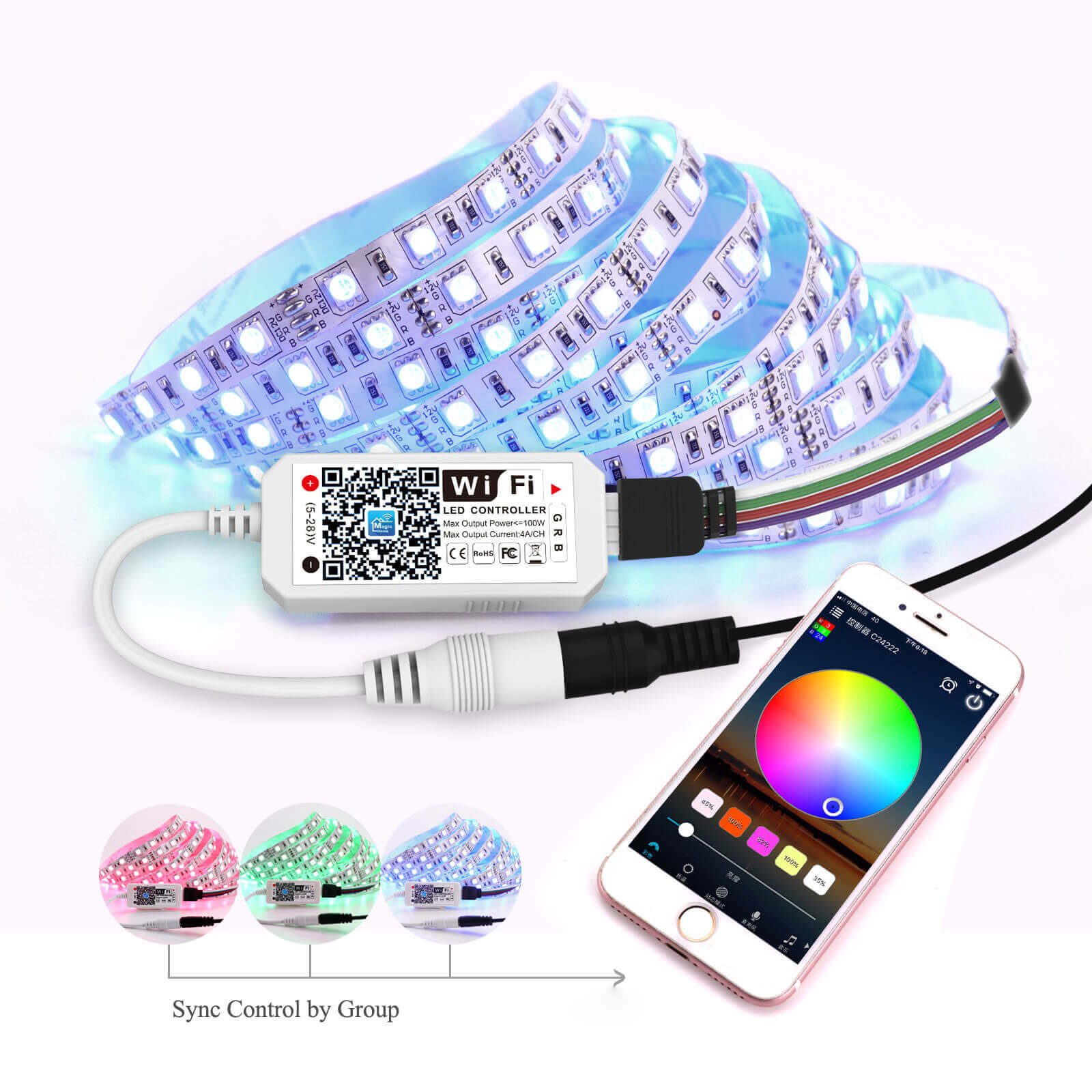LED strip lights offer a creative and energy efficient lighting option that can be installed virtually anywhere. With recent advances in smartphone connectivity, it’s now possible to control LED strips right from your phone. Bluetooth and WiFi-enabled LED strips allow for full customization and automation of accent lighting in your home. Read on to learn how connecting your LED strips to your phone provides convenience and innovation in home illumination.

Table of Contents
ToggleMethods of Connecting LED Strips to Phones
There are two main wireless methods for pairing phone control with LED strip lights – Bluetooth and WiFi. Each has pros and cons to consider for your setup.
Bluetooth Connectivity for Short Range LED Control
Bluetooth provides direct connection between your phone and LED lights within about a 30 foot range. Follow these steps for easy Bluetooth pairing:
- Download the app created by your LED controller brand and install on your phone.
- Plug in the LED lights and locate the Bluetooth pairing button on the controller. Press and hold to activate pairing mode.
- Open the app, scan for available devices, and select your LED lights when displayed. Accept the pairing connection.
- Confirm the lights now respond to app controls. Enjoy Bluetooth light control when in range!
WiFi Links LEDs to Your Network for Long Range Control
WiFi-enabled LED strips connect to your existing router for control anywhere. Here is how to link the lights:
- Note your wireless network name and password to enter during pairing.
- Download the manufacturer app and open it prior to starting.
- Plug the WiFi LED controller into an outlet near the router.
- Initiate pairing mode by pressing the controller button until it blinks.
- Follow in-app prompts to connect the lights to your WiFi using your network info.
- Once connected, you can now control the LED strips from the app remotely.
Key Benefits of Controlling LED Strips via Phone
Beyond just wireless control, phone connectivity brings other advantages to LED strip lighting:
Precise Dimming and Brightness Control
Easily tailor room ambiance by setting custom brightness levels from your phone. Create scenes for activities that require different lighting moods.
Customize with a Full Spectrum of Colors
Choose from a vast range of colors to personalize your space. Program dynamic color loops or select a static color to match your mood.
Automation and Scheduled Lighting
Set lights to turn on, off, dim, or change colors at scheduled times. Automation ensures optimal use for function and efficiency.
Hands-Free Voice Control
Use smart assistants like Alexa for convenient voice activation of lighting scenes, color changes, and more.
Simple, Intuitive Control from Your Phone
User-friendly apps make it easy for anyone to customize their lighting with just a few taps on a familiar device.
How to Connect an LED Controller for Strip Light Control
LED controllers allow full customization of attached LED strip lights. Follow these tips for proper setup:
- Determine the total length of strips to power and required voltage when selecting your controller.
- Use the manufacturer recommended power adapter for that specific controller model.
- Carefully connect LED strip light ends to the output ports on the controller.
- For phone control, sync the controller to the light manufacturer’s app and connect to WiFi.
- Once connected, use the app to control dimming, colors, schedules and lighting scenes.
Group Multiple LED Strips for Unified Control
Most LED strip apps allow you to group multiple lights together:
- Control an entire room’s ambiance without adjusting each light individually.
- Establish groups or zones based on light type or room.
- Activate color or brightness changes across all lights in a group simultaneously.
- Create lighting recipes like “dinner party” or “movie night” and apply them to a group.
Grouping streamlines control of multiple LED strip lights for whole-home illumination.
Advanced Features of LED Controllers for Industrial Use
For large commercial and industrial lighting projects, advanced LED controllers offer capabilities like:
- Centralized control of large LED fixture networks through integration platforms
- Detailed energy monitoring, management and load shedding functions
- Field-configurable control based on industry specific requirements
- Robust built-in surge and transient protection for industrial power fluctuations
- Temperature and fault monitoring with alerts and diagnostics for maintenance
- Backup battery operation and auto-restart after power interruption
- Integration with building management and automation systems through protocols like DALI
These enterprise-level features enable tailored LED lighting solutions for factories, warehouses, office buildings and more.
Integration of LED Controllers in Smart Building Systems
In commercial settings, integrating LED lighting controls into broader building management systems allows:
- Centralized automation and control of HVAC, security, lighting etc. for workflow efficiency.
- Unified data collection, monitoring and analytics of building performance metrics.
- Optimization of energy usage by automating lighting based on conditions and occupancy.
- Voice control, mobile access and automation for flexible but secured control.
- Troubleshooting assistance via fault notifications and remote diagnostics.
- Plug-and-play setup of rooms and zones as your needs change.
For new construction or retrofits, ensure the LED controller solution can interface with smart building dashboards for deeper lighting optimization.
Customization Options in LED Controllers for Commercial Lighting Projects
LED controllers enable businesses to customize lighting to enhance space aesthetics, branding, and workflows:
- Program unique dynamic color sequences or effects that align to branding.
- Craft lighting scenes tailored to specific activities – retail displays, workshops, hospitality.
- Schedule color temperatures tuned to biological cycles – cool for daytime focus, warm for evening relaxation.
- Group control by room types, lines of business, or customer journey path.
- Integrate ambient audio for light shows synchronized to music or sounds.
Specifying commercial LED controllers that offer extensive programming customization provides engaging, purposeful illumination.
Cost-Benefit Analysis of Implementing LED Controllers in Business Settings
While LED controllers require upfront investment, benefits like:
- Energy savings from efficient lighting and automated controls. LEDs use up to 80% less power than traditional lighting.
- Reduced maintenance costs with LED lifespan ratings over 50,000 hours compared to only 5,000 hours for fluorescent or incandescent bulbs.
- Improved safety from low voltage operation and advanced diagnostics and reporting.
- Enhanced workflow and productivity with custom, activity-based lighting.
- Increased customer engagement via unique branding, displays and ambiance.
often provide a less than 2 year ROI making LED controllers a smart business decision. Maintenance and energy savings alone offset costs in most installations.
Latest Trends in LED Controller Technology and Market Forecast
Key developments in commercial LED controllers include:
- Expanded integration capabilities with building automation and IoT systems.
- Advances in POE (Power Over Ethernet) for simplified wiring and networking.
- More mesh networks and wireless controllers minimize installations.
- Cloud hosting platforms provide remote access and data analytics.
- Higher density LED chipsets translate to smaller, more compact controllers.
- Growth in controllers designed specifically for horticultural lighting applications.
The global LED controller market is projected to reach USD $2.63 billion by 2025 driven by increasing adoption of integrated networking and controls in commercial lighting upgrades and green building initiatives.
Case Studies: Successful Implementations of LED Controllers in Various Industries
Retail: 40% energy savings realized by a department store chain using LEDs controlled in zones paired with motion sensors to light sales areas only when occupied.
Warehouse: A logistics company automated warehouse LED lighting color temperatures and dimming levels based on zone and time of day to improve safety and productivity.
Hospitality: Hotels programmed digital LED wall displays at lobbies and lounges to sync lighting with music playlists creating an immersive customer experience.
Office: Utilizing tunable white LEDs tuned to the circadian rhythm helped increase office worker productivity and comfort while lowering power bills by thousands.
These real-world examples showcase the versatility of LED controllers to meet business objectives across industries.
How to Choose the Right LED Controller for Your Business Needs
Selecting the optimal LED controller depends on factors like:
Size of installation – If controlling a limited number of lights, a standalone controller may suffice. Large scale deployments may require a robust networked solution.
Power requirements – Consider the number of LED fixtures, their wattage, and voltage needs. Choose a controller rated to comfortably exceed your total power load.
Control requirements – Determine if basic dimming is sufficient or if advanced programming and integration features are needed.
Connectivity – Assess networking requirements like wireless, POE, or interfaces like DMX, DALI, and BACnet for integration.
Physical environment – For challenging electrical, temperature, humidity or chemical conditions, choose controllers rated for those environments.
Budget – Weigh costs against hardware warranty, reliability, long term TCO, and performance needs.
Aesthetics – For public facing locations, low profile and finishes blending into the space may be preferred.
Thoroughly evaluating the lighting environment, goals, and budget helps narrow the choices to find your ideal LED lighting controller solution.
Networking and Connectivity Solutions for LED Controllers in Large Scale Operations
For expansive commercial LED installations, controllers support various networking protocols:
Wired networking – Use DMX or Ethernet protocols to connect controllers over longer distances without signal degradation.
Wireless networking – Bluetooth, Zigbee and proprietary mesh networks reduce cabling and wiring costs.
POE (Power Over Ethernet) – Runs lighting control signals and provides power over standard Ethernet data cable.
DALI – Digital Addressable Lighting Interface for bidirectional control of fixtures and devices.
BACnet – Building automation integration for sharing lighting data on existing networks.
Wi-Fi – Leverage existing Wi-Fi infrastructure for easy networked control and management.
The right connectivity solution provides needed range, bandwidth, flexibility and scalability tailored to your business.
Regulatory Compliance and Safety Standards for LED Controllers in Commercial Use
In business settings, LED controllers must meet:
- Electrical standards – UL, CSA, CE, RoHS certification for safety and emissions.
- EMC emission standards – FCC limits on conducted and radiated interference.
- Listing standards – Compliance with local and national commercial lighting controls codes.
- Energy codes – Title 24, ASHRAE 90.1, IECC standards for efficiency and conservation.
- Hazardous location certifications – For use in settings requiring explosion proofing.
- Sustainability standards – LEED and other green building programs factoring lighting controls.
Strict compliance ensures proper installation, safety, and optimization for commercial LED lighting. Partner with reputable, certified LED controller manufacturers.
With extensive programming potential and energy saving capabilities, LED controllers offer an ideal solution to customize, automate, and manage advanced commercial lighting. When investigating controllers, conduct thorough diligence to determine the optimal fit for your specific business goals and lighting environment. A purpose-built LED control system allows you to leverage lighting for productivity, savings, and branding.
